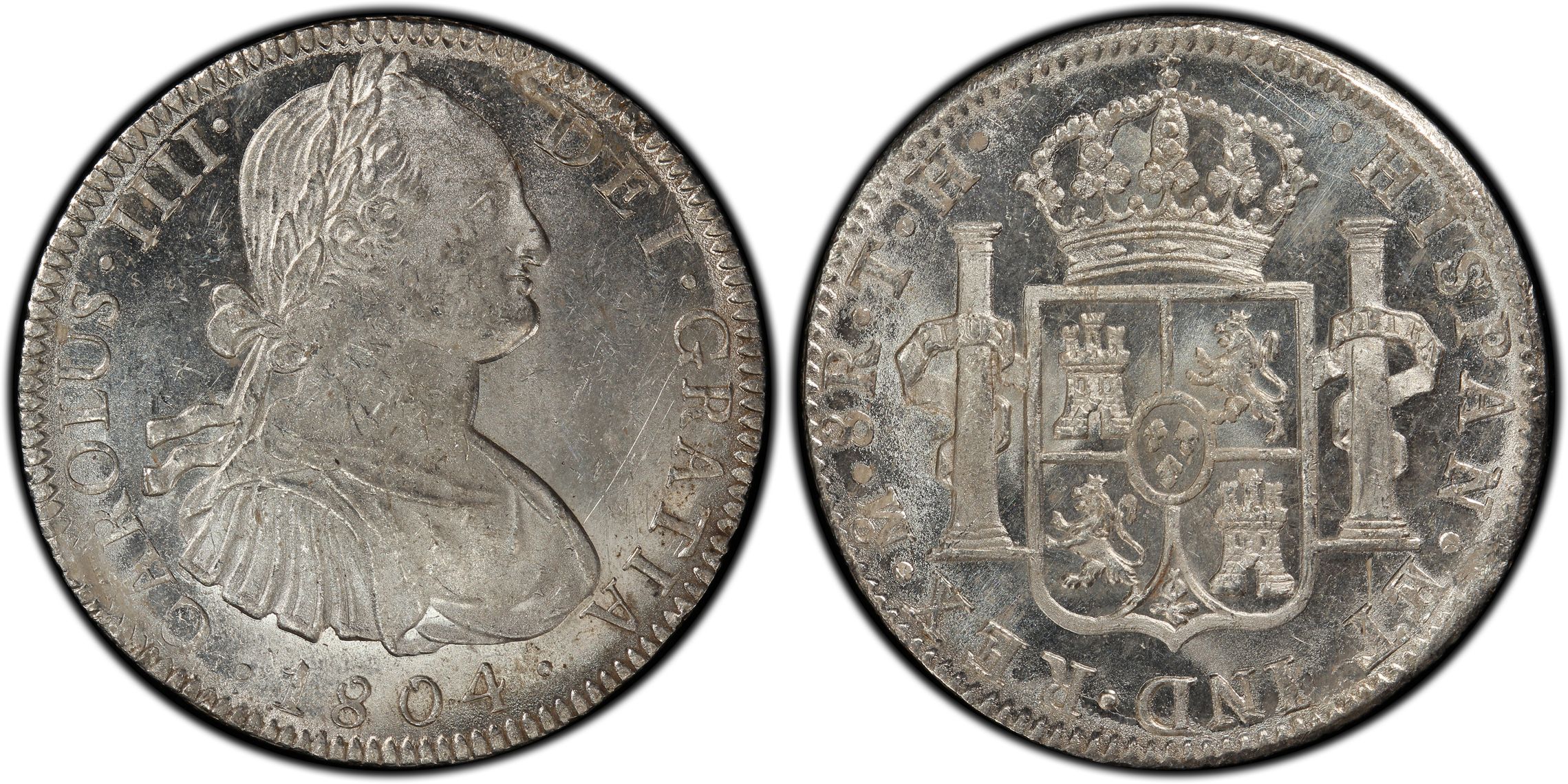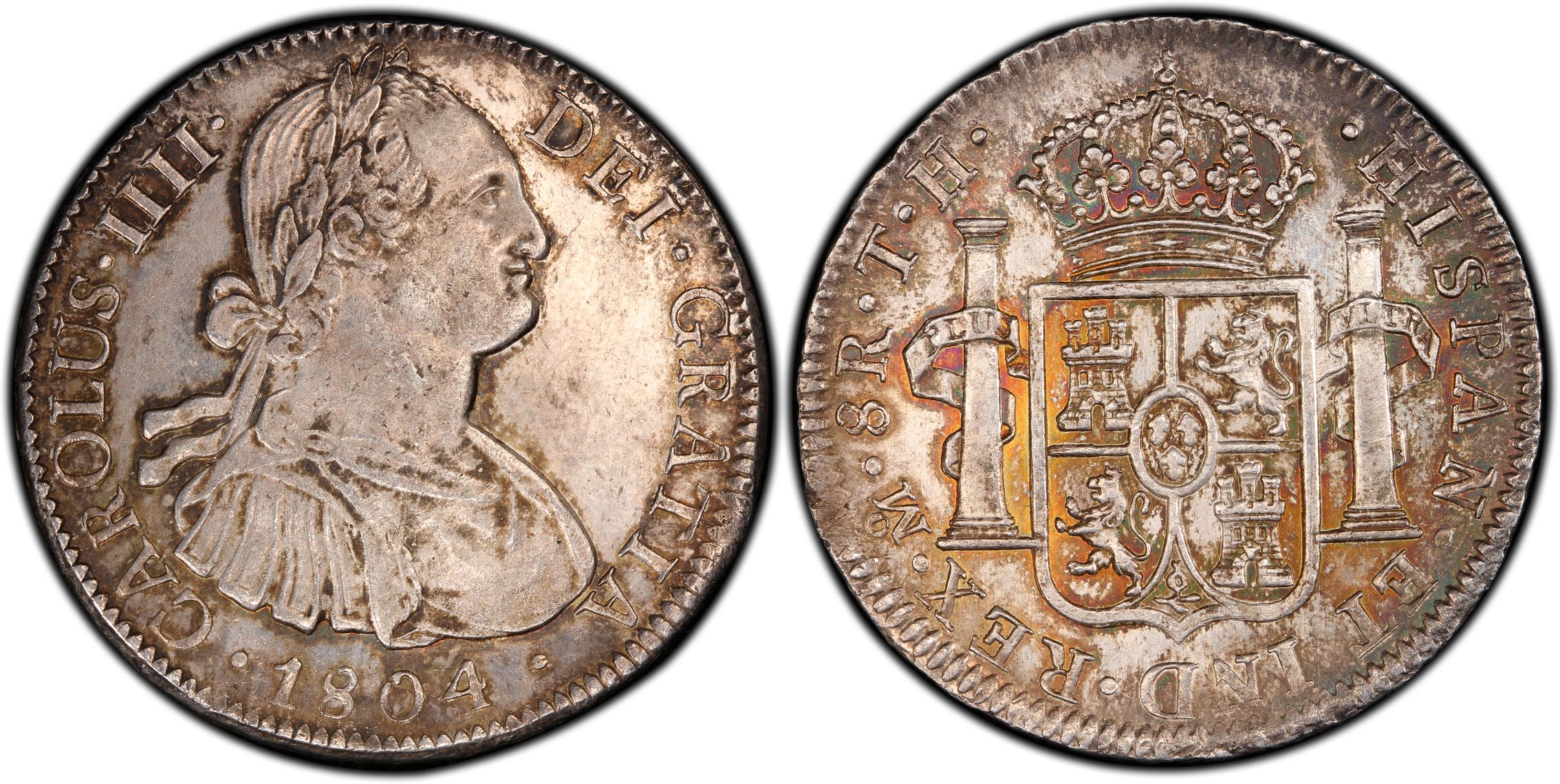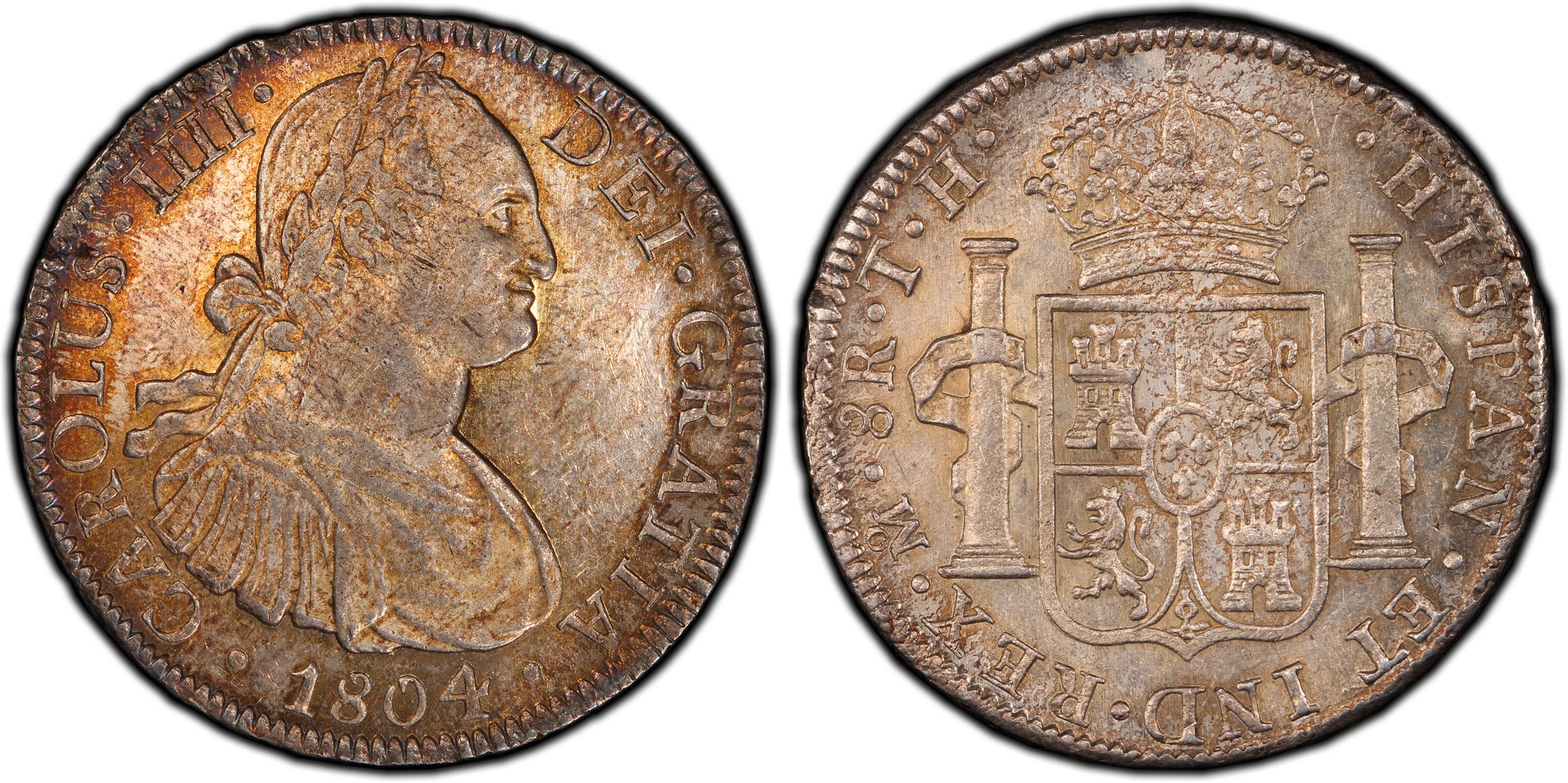Options
MO 8 Reales possible overdate, what do you think?
 MilkmanDan
Posts: 3,761 ✭✭✭✭✭
MilkmanDan
Posts: 3,761 ✭✭✭✭✭
I'm pretty sure this is an overdate but without another example to compare with, I'm not sure. Some of the overdates in this series are very clear while others are less so. At Roman's suggestion I'm opening this up to the forum, would love to hear your thoughts and especially would like to see an example of the 1804/3-MO TH if anyone has a pic. Neither PCGS and NGC have graded this variety and it is not listed in the Calbeto compendium.

Link to larger version of this image
As you can see, there's some extra metal there. It appears to me that the top horizontal bar of the 3 is there, as well as the top right point just barely poking out of the 4. As for the other metal, possibly the die was damaged during the punch of the 4 numeral.
Here's a few examples of the 1804-MO TH for comparison.

Large version

Large version

Large version

Link to larger version of this image
As you can see, there's some extra metal there. It appears to me that the top horizontal bar of the 3 is there, as well as the top right point just barely poking out of the 4. As for the other metal, possibly the die was damaged during the punch of the 4 numeral.
Here's a few examples of the 1804-MO TH for comparison.

Large version

Large version

Large version
0
Comments
P.S. The first 1804 example you posted is a PCGS MS63, which I just acquired from folks at NEN
8 Reales Madness Collection
<< <i>P.S. The first 1804 example you posted is a PCGS MS63, which I just acquired from folks at NEN
Congrats. Any chance to acquire a mint state example in this series is a treat. You've found a couple lately, nice work.
<< <i>I think it's an overdate. Other explanation would be die rust or damage, but then why would it be localized around just one digit of the date? >>
After studying the rest of the coin, I do see a little evidence of some rust, but it's mostly localized. If my theory about overdates being stop-gap issues is correct, a little rust wouldn't surprise me. Here's the obverse and reverse of the coin. Note that it was lightened a bit at some point but is still fairly wholesome.
Large obverse
Large reverse
There is evidence of similar metal bits around the S in CAROLUS, as seen here:
Large version
To my eyes, it looks like the top serif of the S was repaired and the bits are incidental damage. Other than that, I see some die rust towards the lower half of the reverse. The difference being, it's not localized (as you pointed out), being more uniform.
Additionally, that it's not in Calbeto is almost a guarantee it doesn't exist.
Interests:
Pre-Jump Grade Project
Toned Commemoratives
8 Reales Madness Collection
I could definitely see this being die rust, although the overdates in this series are rarely clear. I looked at Roman's 1814/3 HJ - even though it's lower grade the overdate is more clear. His example most prominently shows the top bar of the 3. The example I've shown might also show the top bar of the three, but there's enough other metal around it that it's tough to be sure.
As for Calbeto not listing the coin, I don't take that as proof it doesn't exist. This series is very poorly documented and with his focus spanning so many different countries, with so many rare coins, there are bound to be a few he missed. PCGS lists the coin in the registry with a 2x multiplier, implying that it's scarce or possibly rare. The PCGS coin number is 263361. I'd love to know which reference was consulted when they put together the registry set and applied rarity factors.
Unless I can find some sort of documentation, I'm on the fence about this coin. I might just send it in to see what the experts think.
PS. dOnlyBG, I think that's just crud in the 8.
<< <i>As for Calbeto not listing the coin, I don't take that as proof it doesn't exist. This series is very poorly documented and with his focus spanning so many different countries, with so many rare coins, there are bound to be a few he missed. PCGS lists the coin in the registry with a 2x multiplier, implying that it's scarce or possibly rare. The PCGS coin number is 263361. I'd love to know which reference was consulted when they put together the registry set and applied rarity factors. >>
Dan, I disagree with this.
The series is, in fact, very well documented and Calbeto was "standing on the shoulders of giants." Other than rarity information (due to the recent discovery of hoards, pop reports, etc.), there is little new in Spanish Colonial 8 Reales in the last 100 years. (OK, the discovery of the Charles & Johanna 8R is an important new discovery.)
As for where PCGS got its data, I am supposing Krause. And we all know how accurate Krause data is, right?
<< <i>Dan, I disagree with this.
The series is, in fact, very well documented and Calbeto was "standing on the shoulders of giants." Other than rarity information (due to the recent discovery of hoards, pop reports, etc.), there is little new in Spanish Colonial 8 Reales in the last 100 years. (OK, the discovery of the Charles & Johanna 8R is an important new discovery.)
As for where PCGS got its data, I am supposing Krause. And we all know how accurate Krause data is, right?
Perhaps "very poorly documented" was too strong of language and perhaps I'm weighting my opinion too heavily based on my own inability to find much information, including my mediocre Spanish language skills
Relative to the Pillar and Cap and Rays, I do think the bust/portrait series is somewhat less popular and less documented, but you're right, there's a lot out there. I checked Krause and sure enough, they list an 1804/3-MO TH so that's likely where PCGS pulled the info from.
Having said all this, there may not be much new over the past 100 years but I firmly believe that with more eyes on the series and greater collecting interest we will discover new varieties. At least I hope so.
Here's a PCGS photo of the coin:
Not the pretiest 8 reales I've ever seen but neat to see the first graded of this variety.
Amat Colligendo Focum
Top 10 • FOR SALE
<< <i>Unless I can find some sort of documentation, I'm on the fence about this coin. I might just send it in to see what the experts think. >>
Calbeto is documentation. I would trust that above graders with "focus spanning so many different countries."
Everyone makes mistakes but authors have months and years to research and aggregate data. Graders have 30-60 business days depending on the service level.
Amat Colligendo Focum
Top 10 • FOR SALE
8 Reales Madness Collection
<< <i>Update: I submitted this coin a while back and the grade just posted. I bought it as an ICG 35 and it is now in PCGS 35 plastic. PCGS ended up labeling the coin as an 1804/3 overdate, so at least one "expert" agreed with me. That's not to say we both might be wrong.
Here's a PCGS photo of the coin:
Not the pretiest 8 reales I've ever seen but neat to see the first graded of this variety. >>
It's a lovely looking VF coin, but the fact that PCGS put 1804/3 on the label is often due to the fact that this is what you put on the form when you submitted it. I have seen so many mislabeled coins from both of the top TPGs that stem from wrong data being written on the original submission form to believe that this means "at least one expert agreed with you". It could simply mean that they "trusted" you.
I am by no means an "expert" in this series, but I see no evidence from your images of an overdate. I will say though, those are some damn nice close-up photos!
-~-~-~-~-~-~-~-~-~-~-~-~-~-~-~-~-~-~-~-~-~-~-~-~-~-~-~-~-~-~-~-~-~-~-~-~-~-~-~-~-~-~-~-~-~-~-~-~-~-~-~-~-
My sets: [280+ horse coins] :: [France Sowers] :: [Colorful world copper] :: [Beautiful world coins]
-~-~-~-~-~-~-~-~-~-~-~-~-~-~-~-~-~-~-~-~-~-~-~-~-~-~-~-~-~-~-~-~-~-~-~-~-~-~-~-~-~-~-~-~-~-~-~-~-~-~-~-~-
<< <i>the fact that PCGS put 1804/3 on the label is often due to the fact that this is what you put on the form when you submitted it. I have seen so many mislabeled coins from both of the top TPGs that stem from wrong data being written on the original submission form to believe that this means "at least one expert agreed with you". It could simply mean that they "trusted" you. >>
Totally. I'm on the fence as to what this is and like I stated, I'm not saying PCGS agreeing with me is definitive. The point has been raised that this could be die rust. Something I've observed is that most of the overdates in this series also show die rust in other areas, more commonly than the non-overdates. This is just my observation and others may disagree. To the point though, it's been stated that the presence of die rust elsewhere makes this less likely to be an overdate while I am thinking just the opposite. Unfortunately there's gunk lodged inside the 4, making it tougher to determine.
<< <i>I do think you should share that 1808 that was a part of that submission >>
Shared that one in the Newps thread!
<< <i>Calbeto is documentation. I would trust that above graders with "focus spanning so many different countries."
Everyone makes mistakes but authors have months and years to research and aggregate data. Graders have 30-60 business days depending on the service level. >>
I continue to disagree with this assertion. Let's take another overdate in this series as an example, the 1808/7-MO TH. Calbeto makes no mention but TwoKopeki and I have both recently acquired examples of this variety and have discovered the examples were made from two different obverse dies. This example alone shows that at least one hole exists. The breadth of coverage by Calbeto is astounding, but there have been and will continue to be specialists that take his work as a starting point and add on it. Someday I hope to be considered in that crowd.
Bob
Edit: Of note the coin below has been attributed as an 1814/3 by both NGC and PCGS now.